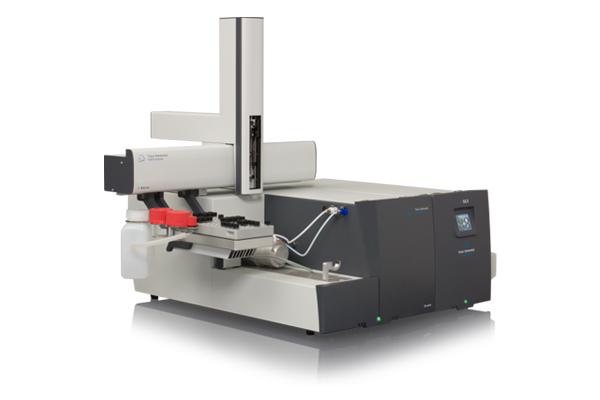Elemental Combustion Analyzer for Total Nitrogen by Chemiluminescence and Total Sulfur by UV-Fluorescence
The XPLORER-NS is the smallest Total Nitrogen (TN) and Total Sulfur (TS) analyzer available in today?s market. This advanced elemental combustion analyzer offers fast, accurate and precise analysis of liquid, LPG, gas and solid samples. It is designed to offer standardized and customized solutions to match current as well as future analytical needs, ranging from low ppb to high ppm applications.
The XPLORER-NS measures Nitrogen and Sulfur simultaneously. Valuable information about a sample that contains both elements is created during a single run. With its low detection limit it is possible to measure concentrations at ppb level. Detection through Chemiluminescence and UV-Fluorescence with sample combustion at high temperature are the reference methods for the determination of Total Nitrogen and Total Sulfur. Separate analysis of Total Nitrogen or Total Sulfur can be done with the XPLORER-N or XPLORER-S.
In the refining process of petroleum products from crude oil, critical contaminants are e Sulphur and nitrogen in addition to the lesser poisoning contaminants such as chlorides, mercury and lead etc. Even the Trace level Sulphur and nitrogen contaminants are also poisonous to the process catalysts and reduces the catalyst efficiency. Also, the Sulphur and other contaminants which remain present in the hydrocarbons causes corrosion in refinery pipelines. For optimizing the refinery process, maintaining product quality during long distance transportation, the reason for trace level determination these two poisonous contaminants become very crucial.
There are various methods for determination of trace levels out of these ASTM D5453 is an standard test method to ascertain the total sulfur in liquid hydrocarbons containing 1.0 to 8000 mg/kg total Sulfur.
Method background:
ASTM D5453 is one of the most used standard test method for the determination of total sulfur content in liquid hydrocarbon matrixes boiling in the range of 25 to 400 °C. Viscosities for this method lay between 0.2 and 20 cst(mm2/S). Samples like naphthas, diesel, jet fuels, kerosenes, engine oils, ethanol, Fatty Acid Methyl Esthers (FAME) and their blends with fossil diesel, gasolines oxygen enriched and ethanol and methanol blends such as E85, M85 and RFG can be analyzed by this method utilizing direct syringe injection. Precision statement was calculated based on samples containing total elemental sulfur between 1 and 8000 mg/kg.
Method principle:
Methods based on UV Florescence, involves general principle;
Fluorescence generally occurs when a fluorescent molecule (fluorophore) resonantly absorbs electromagnetic radiation that promotes it to an excited electronic state. Subsequent radiative relaxation of the excited states results in emission of light, where some of the excitation energy is lost through heat or vibration, and part is emitted at longer wavelengths, compared to the excitation radiation.
Relating to the sulphur, nitrogen determination the principle involves:
A hydrocarbon sample is either directly injected or placed in a sample boat. The sample or boat, or both, is inserted into a high temperature combustion tube where the sulfur is oxidized to sulfur dioxide (SO2) in an oxygen rich atmosphere. Water produced during the sample combustion is removed and the sample combustion gases are next exposed to ultraviolet (UV) light. The SO2 absorbs the energy from the UV light and is converted to excited sulfur dioxide (SO2*). The fluorescence emitted from the excited SO2* as it returns to a stable state, SO2, is detected by a photomultiplier tube and the resulting signal is a measure of the sulfur contained in the sample.
Nitrogen in the sample is converted to NO and chlorine in the sample is converted to HCl. Water in the combusted sample is removed and then the gas is sent to the relevant detector. Nitrogen detection – the sample gas is mixed with ozone. A chemiluminescence reaction takes place:
NO + 03 → NO2* + O2
NO2* → NO2 + light (infrared)
The light emitted from the reaction is proportional to the amount of nitrogen in the sample. Sulfur detection – a pulsed UV light source illuminates the sample and the fluorescence from the SO2 molecule is measured. The fluorescence signal is proportional to the amount of sulfur in the sample. Chlorine detection – a wet chemistry technique using titration of silver in acetic acid. The sample gas is bubbled into the titration cell and the chlorine in the gas creates an electric charge. This is an absolute technique so the electric charge measured is equal to the amount of chlorine in the sample – no calibration required.
Instrumentation:
A measured quantity of the hydrocarbon sample is either directly injected into the pyrotube of the analyzer at a controlled speed into the vaporization and combustion zones of the instrument. In the inlet zone the sample is transported by an inert stream of a carrier gas, typically Argon or Helium. The hydrocarbon is oxidized in a rich pure oxygen stream in the combustion zone at approximately 1000°C where it is converted into CO2, SO2 and H2O. After the gases exit the combustion zone they are passed through a semipermeable membrane where the water is quantitatively removed. The gases enter the Sulfur reaction chamber where they are exposed to an UV light. The SO2 molecules absorb the radiation and become excited. The relaxation takes a few nanoseconds releasing a secondary energy which is captured by a Photo Multiplier Tube, amplified processed and recorded. The signal obtained is proportional to the total sulfur content of the original sample.
Xplorer-NS is capable of analyzing a range of hydrocarbon products including LPG and comparable with various methods of similar technique.
The Xplorer-NS measures Nitrogen and Sulfur simultaneously. Valuable information about a sample that contains both elements is created during a single run. With its low detection limit it is possible to measure concentrations at ppb level. Detection through Chemiluminescence and UV-Fluorescence with sample combustion at high temperature are the reference methods for the determination of Total Nitrogen and Total Sulfur. Separate analysis of Total Nitrogen or Total Sulfur can be done with the Xplorer-N or Xplorer-S.

